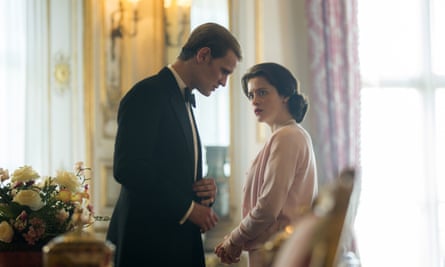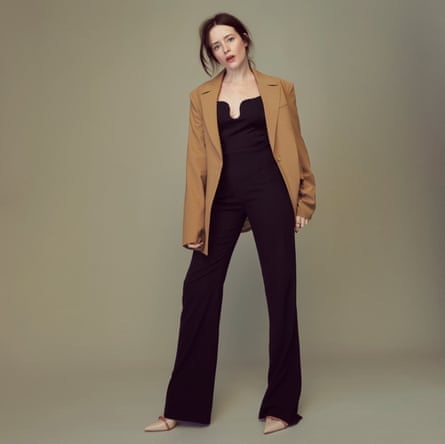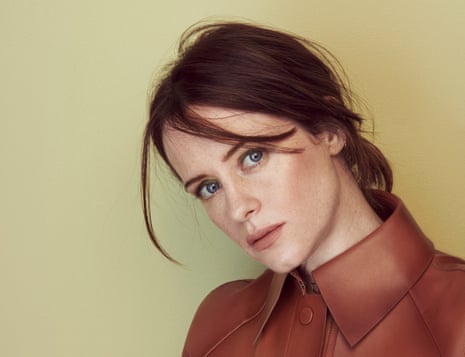In a cafe in north London, over scrambled eggs and tea, Claire Foy is gearing up to put herself down. When she reads celebrity interviews, she says, she finds herself agreeing with the subjects, as if they have all the answers. “They exercise every day, and they don’t drink any more. They’ve got all these views which are really pertinent and interesting. I really think there’s this feeling that everyone is doing it better, all the time.”
It turns out that she has a habit of being hard on herself, though she often disguises it as a joke. In this case, anyway, she’s wrong, as she is about to express plenty of views that are pertinent and interesting, about all manner of things, from pay disputes, to her struggles with anxiety, to Matt Smith’s bottom. “I just sit there and go, ‘Oh, I don’t know what I’m doing with my life,’” she shrugs.
Foy arrives in the cafe on time, to the minute, and apologises for turning up with wet hair, which will, she says, be massive by the time it’s dry. We are here to talk about her latest film, Women Talking, which I finish watching barely an hour before we meet. “Oh God,” she says, half apologetically. “I mean, you might need some time to digest it.”

Directed by Sarah Polley and up for best picture at this year’s Oscars, Women Talking is a beautiful, harrowing, hopeful film, in which Foy stars alongside Frances McDormand, Jessie Buckley and Rooney Mara. It tells the story of a strict, isolated Mennonite religious community, whose women discover that they have been systematically drugged and raped by some of the men for years. The culprits are arrested and taken to a police station, and as the other men go to bail them out, the women are left with a day alone to decide what they should do. The film shows their debate, in a hayloft. Should they stay and do nothing, stay and fight, or leave?
Foy’s character, Salome, makes quite the entrance. “She’s trying to scythe some people’s heads off,” Foy says, brightly. Salome is justifiably furious – her four-year-old daughter has been raped – yet Foy says that in her own life, anger does not come naturally.
On screen, she had to dig in and find the rage. “I had to not pull back. I had to not want to make her smaller. I’ve seen a lot of angry men in films, with their eyes bulging out, and there’s something OK about that. But angry women obviously get told they’re shrill or, what did someone once say to me? Head girly.” She winces as she recalls this; it has the ring of a long-remembered insult. “I was never head girl. You have to think so much, as a woman, about how you communicate in order to get your point heard. You have to make sure that it’s palatable in some way.”

She doesn’t think she grew up seeing many women being angry. “But you’ve got to get it out, in order to move on. I couldn’t. I just lived in denial that I had any.” She did, of course, have things to be angry about, but she didn’t know how to express it. “I’d be a really rageful driver, or I’d be really passive-aggressive, because I couldn’t say what I wanted or needed.”
Is she any better at expressing herself now? “I’m trying.” Foy has a seven-year-old daughter, and she tells her not to be afraid of anger. “Because she doesn’t need to calm down. If she’s angry, OK, be angry then. Get it out, jump around, really scream. And then it only lasts minutes.” She pauses. “Now, this would be ideal parenting. It’s not what I do all the time. Obviously I’m not in control of what’s happening in the world, or to a certain extent, my life.” She smiles, cracks a joke. “Obviously I’m still a rageful driver.”
Though she had been working solidly since 2008, Foy became properly, internationally famous in 2016, when she played the young Elizabeth II in the first two seasons of The Crown. She was 31, and this was already her second monarch. In 2015, when she was pregnant, she played Anne Boleyn in Wolf Hall, the BBC’s adaptation of the Hilary Mantel novel and its follow-up, Bring Up the Bodies. She met Mantel when they were filming. “What a wonderful woman. Magical. And the first thing I said to her was, ‘Oh, what are you having for lunch, Hilary?’” She cringes. “I thought, she’s written me off straight away. I’m dull, I’m uninteresting, I should have said something really fascinating about 19th-century literature, and I’ve just been a moron.”
After The Crown appeared, and became a massive hit, Foy won two Emmys, a Golden Globe and two Screen Actors Guild awards for her Elizabeth, and was invited to host Saturday Night Live. (Recently, she has been watching her co-star Matt Smith in House of the Dragon, frosty blond wig and all. “I’m a very supportive friend. I think he should dye his hair, because he looked great as Prince Philip blond, as well. Could have done without seeing his bottom quite so much,” she says.) She returned to the fifth season of The Crown with a surprise cameo, in a flashback, much to the delight of fans.

Early in 2018, however, Foy, Smith and The Crown were headline news for different reasons. On a TV industry discussion panel, an executive from Left Bank Pictures, the production company that makes the show, revealed that Smith had been paid more than Foy, who was the lead in the series, featured in practically all the scenes and had won all those awards. It came just after Michelle Williams learned that she had been paid far less than her male co-star Mark Wahlberg for reshoots on the film All the Money in the World (reportedly $1,000, to his $1.5m), and Foy and the show became the centre of a fierce debate about pay equality.
I want to ask about the pay situation, I begin. Foy crosses her eyes, and then rolls them. You’re pulling a spectacular face, I tell her. “Because I don’t know whether to be honest or not,” she replies. “I don’t know how much shit to cause.”
Did she know that Smith was being paid more than her, or did she first hear about it when it was in the news? “That was the first I’d heard about it.” At the time, she said the situation was “embarrassing”. Was she shocked by it? “I wasn’t shocked. I was very upset. Not like, boohoo, crying upset. I was very upset.” Were you expressing anger? She puts on a daft, silky voice. “I don’t think I allowed myself to.”
She snaps back to briskness. “I really love my industry, and I think it is made up of lots of honourable, incredibly talented, brilliant, imaginative, amazing people.” But she says it is the same for anyone doing any job they love: writing, music, nursing, anything. “Sometimes, you see something, you hear something, you notice something, or something happens to you, and you just go, ‘Oh God, what am I doing? Why am I doing it? Should I be part of this?’ I found it really heartbreaking.”
At the time, she was polite, almost evasive, saying first that it was “very, very odd” to be at the centre of the storm. She is more direct today. “Suddenly I was getting asked all these questions and being encouraged by certain people involved to be the spokesperson for it. I was like, ‘Absolutely fucking not.’”

What certain people are we talking about? “Can’t say,” she says, firmly. “I just think everybody wanted me to behave in a certain way, in response to it. And I didn’t.” What certain way? She adopts a breezy tone. “‘It’s fine! It’s absolutely fine what happened!’ That’s what I think they wanted me to say. I mean, it’s so hard. I don’t think I should be honest about certain things about it, because I don’t think it would be helpful. It would add more fuel to it. We’re still talking about this, however many years down the line. I know the extent of it. I still went back on the show. If anything, I just didn’t want my experience of the show and what we all did on it to be overshadowed.” She says she doesn’t think it has been, but for someone so jokey about most things, it’s notable that she can’t bring herself to joke about this. “If I could make a joke about it, I would. It’s best just to shut up and endlessly bore your friends with the actual details, poor things,” she says.
She will say that the row has had “an amazing impact, subsequently. You can’t lie now.” A woman came up to Foy and told her that she had been paid fairly for a job because of what had happened. “She was saying it like I’d done something, and I was like, ‘I’ve literally done nothing at all. A newspaper article, and being really shamed … ’” Did it feel like shame? “No. It felt like all the attention was on me. And it shouldn’t be on me. I’m not the decision-maker in this process. Go and talk to them about it. Ask them what their reasoning is. Ask them why they did that. Ask them to be honest about everything. Not me.”
At the time, Left Bank Pictures publicly apologised to both Foy and Smith, claimed sole responsibility for setting actors’ salaries, and pledged to do better. And as Foy says, she did go back to The Crown, even after all that. Did you quadruple your fee, at least? “Ha! No. That would have been great. I think my agent probably enjoyed going back to them,” she says, smiling.
Foy was born in Stockport, Greater Manchester, in 1984, to a salesman father and a mother who worked in pharmaceuticals, and was the youngest of three kids. When she was small, the family moved around the north, also living in Manchester and Leeds. Her parents divorced when she was eight, and she moved to Buckinghamshire, but until that point she had a northern accent. “When my mum and dad were still together, he had a camcorder, and I was a very precocious, attention-seeking child. There’s a video of me going [puts on a Mancunian accent], ‘Are yer filming them, Dad? Are yer?’” It’s often the case that actors come from restless backgrounds. “Yes. I suppose we’re all – I don’t want to say ‘damaged in some way’, but something wasn’t quite right, somewhere down the line, and that’s what leads you to want that much attention, or to want to be seen.”
But it sounds as if she has always liked attention, from an early age? “I was told I was an attention-seeker. I imagine it’s because I was the youngest of three kids – there wasn’t a lot of attention to go around. My one waking thought was: must get parents to pay attention to me.” She learned very quickly not to be “too much”, she says, though not because anyone told her she was. “It just becomes what you believe about yourself.”
As a teenager, it shifted, and she found she was desperate not to be noticed. “I was like, [she squeaks this out, in a tiny voice] ‘No, not me, don’t pay any attention to me!’” Yet despite her sudden shyness, she was still telling herself that she was too much. “I was still beating myself round the head, going ‘You’re so annoying.’” She says this so cheerfully that I don’t realise how brutal it sounds until I listen to the conversation back.

She worked throughout her teenage years. “Inappropriately aged,” she says. “I was 13 when I got my first job, in a pub.” She was a waitress. “I had an abject terror of getting an order wrong.” She does an impression of someone taking an order with tremendous intensity, her voice trembling. “So it’s right that you want two beef and one lamb?” She worked at Tesco for a while. “It was a pit of teenagers all trying to snog each other all of the time. It was like a youth club with supermarket trolleys.” Her older sister told her she should work. “She was like, ‘Get a job, get out.’ So I’ve always been very clear about that.”
When she first started acting, she struggled with the instability of it. “Because you had to be available all the time. And I was like, ‘What? I can’t temp? How am I going to earn money?’ But luckily, as soon as I started working, I kept getting given little nuggets.” She went to drama school in Oxford, and when she left moved to a shared house in London, where she found herself in a “huge, anxious spiral”. She didn’t know what to do with herself. “My friends were all at work. I was in London thinking, ‘I can’t spend any money.’ The idea of exercise was not a thing. I think I did a Geri Halliwell yoga video. That was the extent of the exercise I knew.”
To call her early jobs “little nuggets” is modest. Foy made her stage debut in a Dennis Kelly play, DNA, at the National Theatre in 2008. While she was there, she found out that she had been cast as the lead in the BBC’s new Dickens adaptation, Little Dorrit. “I grew up watching Pride and Prejudice with my cousins, my aunties. BBC period drama was wildest dreams territory. And I didn’t believe it. I just didn’t believe it was happening.” She was already struggling with her mental health, she says. “I wasn’t sleeping, wasn’t really eating a lot. When I was at the National, I wasn’t really enjoying my life. All the fundamental things I thought about myself weren’t very positive, and [success] was at odds with what I believed about myself.”
She had a breakdown. Eventually, her sister intervened. “She was just like, ‘You’re not well.’” She saw a therapist, at her sister’s insistence. “And he helped me get through it. But it was very overwhelming. I felt like I was 1,000 years old.” She realises now that for most of her friends life in their 20s had been a completely different experience. “I didn’t see acting as something I could take for granted. I was like, ‘I don’t even know why I’ve been given this opportunity, I can’t fuck this up.’ It felt like life was serious. I’m really relieved that I’m not doing that now. It was exhausting.”

Little Dorrit was a smash, and afterwards Foy, who got rave reviews for it, did a lot of British television, some US television and plenty of films, starring alongside Nicolas Cage, Ryan Gosling, Benedict Cumberbatch. But the two pivotal projects, Wolf Hall and The Crown, both involved playing a queen. Did she know she would have such a royal career? “Oh, no. Ridiculous, really. Actually laughable. I realised when I was doing The Crown that it was my second coronation.” Were you over it, at that point? “Coronations are not fun, I’ll tell you that. They are long. But they were very different things. Anne Boleyn loved it. It was her moment of glory. She lay down on her pregnant belly in the cathedral as she was crowned. Elizabeth was just like, ‘Don’t look at me, don’t look at me, I’m here as the Almighty’s chosen one, don’t look at me.’ So it was a very different experience of living inside those two moments.”
Last summer, Foy shot a film with the director Andrew Haigh, called Strangers, with Paul Mescal and Andrew Scott, “who are dreamy”. She is between jobs, but she strikes me as someone who likes to be busy. “Some days are busy, some days are not busy, and I panic, and go, ‘Oh my God, what am I going to do?’” For now, she’s keeping herself occupied, baking, cleaning, walking her dog. She has just set up a home office, “to try to make myself feel legitimate. Normally I do work around the house and there would just be piles of paper and books and shit everywhere, and nothing would be right, and then I’d have a cup of tea, and I’d knock the tea over.” At least now, she says, she has a place for it. “Just a room, with all my crap in it.”
How is her anxiety these days? “I have become a very sage, wise person who has all the answers,” she quips. “No, I think from now on, I will always be trying to figure out, not how to be better, but how not to be so hard on myself. Like, just enjoy your life. Just enjoy it. And if that means bad things are going to happen, bad things are going to happen.”
Certainly, Foy has had a tough time of it lately. For legal reasons she cannot talk about it, but in January, after a long legal process, a man was given a 22-month suspended sentence and will be repatriated to the US after subjecting Foy to a horrendous stalking ordeal. He sent her more than 1,000 emails in a month, repeatedly contacted her sister and her agent, and turned up at her house. In a statement read to the Old Bailey at the sentencing, she said it had left her “terrified and helpless in my own home”. “I view the world in a much more fearful way as a direct result of his actions,” she said.
Originally, Foy wasn’t up for Salome in Women Talking. She went in to discuss playing Ona, the serene, almost ethereal woman played by Mara. (“I would have been acting all whimsical and trying to be spiritual, and it would have been absolutely horrendous,” she goofs.) During her first conversation with Polley, the director asked her which woman she felt most like. “And I was like, the really angry, annoyed one,” she says, laughing, as if that, like her queens, is somehow ridiculous. But, I have to say, it suits her.
Women Talking is released in cinemas on 10 February.
Comments on this piece are premoderated to ensure discussion remains on topics raised by the writer. Please be aware there may be a short delay in comments appearing on the site.

Comments (…)
Sign in or create your Guardian account to join the discussion